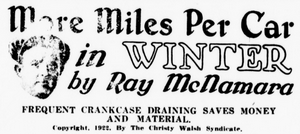|
By accessing or using The Crittenden Automotive Library™/CarsAndRacingStuff.com, you signify your agreement with the Terms of Use on our Legal Information page. Our Privacy Policy is also available there. |

More Miles Per Car in WINTER
|
|---|
|
|
More Miles Per Car in WINTER
Ray McNamara
Washington Times-Herald
December 24, 1922
LUBRICATION—MOST IMPORTANT AND MOST NEGLECTED.
Copyright, 1922, By The Christy Walsh Syndicate.
It has been suggested on several occasions in these articles that approximately 80 per cent of all present day motor car troubles originate either through using insufficient or poor quality of oil. In one case the crankcase gauge might indicate full, but if the oil pump is not delivering fast enough to rods, main bearings, etc. this is bound to cause much damage. In the other case you may be using your oil too long, or possibly through poor mixture, the oil is being contaminated in the crankcase by leakage past the piston rings; for no matter how good your rings may be, rich mixtures will thin out the film of oil between piston and cylinder wall, permitting unburnt gas to escape into your crankcase oil.
The latter condition does not always result in immediate failure under normal service conditions. However, it does cause excessive wear, loss of power and economy, and if you should happen to have occasion to drive with a wide open throttle for a few miles with your crankcase oil badly diluted, complete destruction of bearings is almost certain to follow.
Therefore, in order to combat the above conditions, it is recommended that every car owner make a thorough study of motor lubrication in his car instruction book and find out what kind of oiling system he is using and its characteristics for all systems, owing to the respective designs, have some peculiarities. Do not fail to note the grade and quality of oil recommended by the maker.
Some cars are equipped with straight splash systems for motor lubrication, one in which the oil is usually pumped to troughs located above the oil reservoir and directly under the connecting rods. Spoons or dippers in the bottom of rods splash the oil from these troughs, thus lubricating all bearings and reciprocating parts.
Another form is the combination force feed and splash, in which the oil is pumped under high pressure to the main bearings and to troughs under the connecting rods. In this design the rods and reciprocating parts depend on splash lubrication whilethe main bearings receive lubrication under the pressure.
In the full force feed design of motor lubrication, the oil is supplied to all bearing surfaces under pressure; tubes from the oil distributor leads the oil into main bearings. Holes drilled through the crankshaft at main bearings lead the oil to crank pins (connecting rod bearings). At a rule, the pistons, cam-shaft, tappets, etc., are taken care of by the overflow from sides of bearings, which by centrifugal action of the crankshaft is sprayed on to all reciprocating parts. In some designs, additional oil leads distribute lubrication under pressure to cam-shaft bearings, and to cylinder walls and pistons via the connecting rod and piston pin.
In connection with these systems a gauge is always supplied to show the level of oil in the crankcase or oil reservoir; in addition to this a gauge is usually supplied on the dash to show that the oil is circulating. In some cases a glass gauge indicates circulation, while in the majority of designs, a pressure gauge indicates the rate of flow in pounds.


















